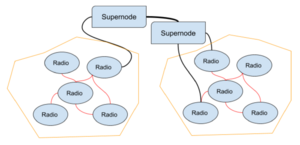Supernodes
Supernodes are a mechanism to connect multiple meshes together, without just making one giant mesh. The original proposal can be found here.
The Basic Idea
The basic idea behind a supernode connected mesh, is that each mesh is it's own self contained "zone", but these zones can communicate with each other by routing inter-zone traffic through a set of supernodes. Supernodes know about all the nodes in all the meshes and take care of routing traffic to where it needs to go, without burdening your average mesh node with this information.
Status
The supernode infrastructure is supported in the nightly build series. It is not yet available as a release build.
To use the supernode infrastructure you must be running a nightly build (20230927 or later) on your localnode. Your localnode is the node you resolve if you type http://localnode.local.mesh info your web browser when connected to the mesh.
For a list of current supernode connected meshes see the list below. If you want to join this group, please contact KN6PLV (tim.j.wilkinson@gmail.com) who will help your mesh get setup.
Maps of Connected Meshes
Current Supernodes
Bay Area Mesh
- KN6PLV-BAM-SUPERNODE
Oklahoma City Mesh
- KI5VMF-CLOUD-TUNNEL-SUPERNODE
Southern California Mesh
- W6BI-BACKBONE-NODE
Willamette Valley Mesh
- K1RKS-Supernode
Dayton Ohio Mesh
- NC8Q-SUPERNODE
Hawaii Mesh
- WH6AV-SUPERNODE
Arizona Mesh
- AB7PA-SUPERNODE
Alternate Approach
Mark Herson N2HM has been operating an alternate supernode approach since 2016. He uses a Hub node which connects to many other meshes, but doesnt share any of the connected meshes data between each other. It's possible the browse these connected meshes by using a web proxy pointing at this hub.
It is not currently possible for one mesh node to connect directly to a node on another mesh. Redundant hubs are not currently provided.
